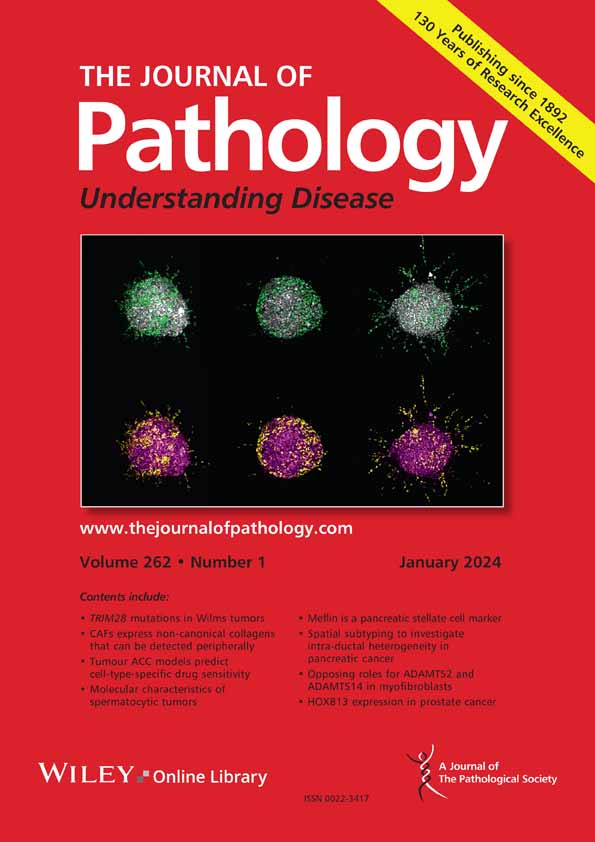Zhanzhan Li, Baishuang Yang, Meihua Long, Jiarong Chen, Yaofeng Zhi, Ronggang Li, Lixue Cao, Shasha Yang, Jingyi Sun, Zijie Meng, Wanting Wu, Yanyang Mai, Xin Zhang, Yanming Huang, Qiong Chen, Aibin Liu
求助PDF
{"title":"沉默GRHL3通过SIRT1增强SOX2稳定性促进肺鳞癌多器官远处转移。","authors":"Zhanzhan Li, Baishuang Yang, Meihua Long, Jiarong Chen, Yaofeng Zhi, Ronggang Li, Lixue Cao, Shasha Yang, Jingyi Sun, Zijie Meng, Wanting Wu, Yanyang Mai, Xin Zhang, Yanming Huang, Qiong Chen, Aibin Liu","doi":"10.1002/path.6385","DOIUrl":null,"url":null,"abstract":"<p>Aberrant expression of grainyhead-like transcription factor 3 (GRHL3) has been extensively reported in the development and progression of several squamous cell carcinomas, such as cutaneous, head and neck, and esophageal squamous cell carcinoma. However, the clinical significance and biological roles of GRHL3 in lung squamous cell (LUSC) carcinoma are largely unclear. Herein, we report that GRHL3 was significantly upregulated in lung squamous epithelium of LUSC tissues, bronchiole, and bronchus. Moreover, expression levels of GRHL3 were decreased with the advance of pathological grade, and low GRHL3 level presented poor overall survival and short progression-free and distant metastasis-free survival in LUSC patients but had no prognostic significance in LUAD patients. Functional experiments <i>in vivo</i> showed that downregulating GRHL3 promoted not only lung colonization and growth but also multiple organ distant metastasis of LUSC cells, including bone, brain, and liver. Moreover, silencing GRHL3 promoted anoikis resistance and cancer stem cell (CSCs) characteristics of LUSC cells <i>in vitro</i>. Mechanistically, silencing GRHL3 stabilized SOX2 via SIRT1-mediated decreasing acetylation and subsequent ubiquitination-dependent degradation in LUSC cells. Thus, in-depth understanding of the underlying mechanism of GRHL3 in the progression of LUSC will facilitate the development of prognostic biomarker and therapeutic avenues against LUSC, which will present favorable prospects in improving outcomes of LUSC patients. © 2025 The Pathological Society of Great Britain and Ireland.</p>","PeriodicalId":232,"journal":{"name":"The Journal of Pathology","volume":"265 3","pages":"302-315"},"PeriodicalIF":5.6000,"publicationDate":"2025-01-13","publicationTypes":"Journal Article","fieldsOfStudy":null,"isOpenAccess":false,"openAccessPdf":"","citationCount":"0","resultStr":"{\"title\":\"Silencing GRHL3 promotes multiple organ distant metastasis of lung squamous cell carcinoma cells by enhancing SOX2 stability via SIRT1\",\"authors\":\"Zhanzhan Li, Baishuang Yang, Meihua Long, Jiarong Chen, Yaofeng Zhi, Ronggang Li, Lixue Cao, Shasha Yang, Jingyi Sun, Zijie Meng, Wanting Wu, Yanyang Mai, Xin Zhang, Yanming Huang, Qiong Chen, Aibin Liu\",\"doi\":\"10.1002/path.6385\",\"DOIUrl\":null,\"url\":null,\"abstract\":\"<p>Aberrant expression of grainyhead-like transcription factor 3 (GRHL3) has been extensively reported in the development and progression of several squamous cell carcinomas, such as cutaneous, head and neck, and esophageal squamous cell carcinoma. However, the clinical significance and biological roles of GRHL3 in lung squamous cell (LUSC) carcinoma are largely unclear. Herein, we report that GRHL3 was significantly upregulated in lung squamous epithelium of LUSC tissues, bronchiole, and bronchus. Moreover, expression levels of GRHL3 were decreased with the advance of pathological grade, and low GRHL3 level presented poor overall survival and short progression-free and distant metastasis-free survival in LUSC patients but had no prognostic significance in LUAD patients. Functional experiments <i>in vivo</i> showed that downregulating GRHL3 promoted not only lung colonization and growth but also multiple organ distant metastasis of LUSC cells, including bone, brain, and liver. Moreover, silencing GRHL3 promoted anoikis resistance and cancer stem cell (CSCs) characteristics of LUSC cells <i>in vitro</i>. Mechanistically, silencing GRHL3 stabilized SOX2 via SIRT1-mediated decreasing acetylation and subsequent ubiquitination-dependent degradation in LUSC cells. Thus, in-depth understanding of the underlying mechanism of GRHL3 in the progression of LUSC will facilitate the development of prognostic biomarker and therapeutic avenues against LUSC, which will present favorable prospects in improving outcomes of LUSC patients. © 2025 The Pathological Society of Great Britain and Ireland.</p>\",\"PeriodicalId\":232,\"journal\":{\"name\":\"The Journal of Pathology\",\"volume\":\"265 3\",\"pages\":\"302-315\"},\"PeriodicalIF\":5.6000,\"publicationDate\":\"2025-01-13\",\"publicationTypes\":\"Journal Article\",\"fieldsOfStudy\":null,\"isOpenAccess\":false,\"openAccessPdf\":\"\",\"citationCount\":\"0\",\"resultStr\":null,\"platform\":\"Semanticscholar\",\"paperid\":null,\"PeriodicalName\":\"The Journal of Pathology\",\"FirstCategoryId\":\"3\",\"ListUrlMain\":\"https://onlinelibrary.wiley.com/doi/10.1002/path.6385\",\"RegionNum\":2,\"RegionCategory\":\"医学\",\"ArticlePicture\":[],\"TitleCN\":null,\"AbstractTextCN\":null,\"PMCID\":null,\"EPubDate\":\"\",\"PubModel\":\"\",\"JCR\":\"Q1\",\"JCRName\":\"ONCOLOGY\",\"Score\":null,\"Total\":0}","platform":"Semanticscholar","paperid":null,"PeriodicalName":"The Journal of Pathology","FirstCategoryId":"3","ListUrlMain":"https://onlinelibrary.wiley.com/doi/10.1002/path.6385","RegionNum":2,"RegionCategory":"医学","ArticlePicture":[],"TitleCN":null,"AbstractTextCN":null,"PMCID":null,"EPubDate":"","PubModel":"","JCR":"Q1","JCRName":"ONCOLOGY","Score":null,"Total":0}
引用次数: 0
引用
批量引用

 求助内容:
求助内容: 应助结果提醒方式:
应助结果提醒方式:


